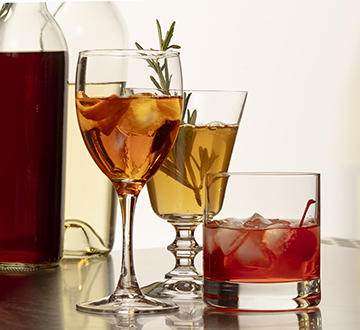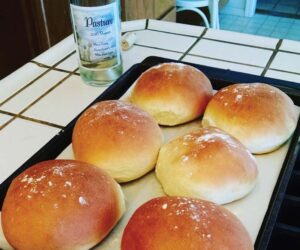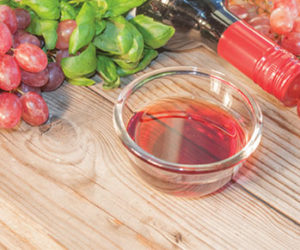
Wine cocktails are increasing in popularity, despite hesitation by some. While certainly not a new concept by any means, integrating wine in a drink is aligning with current beverage trends, such as innovative cocktails and lower-alcohol options (since wine often has less ABV than a spirit).
But you can’t explore the world of wine cocktails without giving credit to numerous popular classics – the mimosa, red and white sangria, mulled wine, bellini, aperol spritz (and many other spritzer variations), and even vermouth-based (fortified wine) cocktails such as martinis, manhattans, and more.
Besides these cocktail menu mainstays, there are plenty of other wine-laden cocktails you may have sampled along the way. The Kalimotxo is a Spanish cocktail made of just dry red wine and cola. The St-Germain cocktail blends dry white wine or Champagne with St-Germain elderflower liqueur and club soda. A Negroni Sbagliato is a twist on the popular Italian drink utilizing Prosecco instead of the traditional gin along with Campari and sweet vermouth.
Despite the delicious potential, many winemakers scoff at the idea of altering their perfectly constructed wine in a cocktail, says Jayme Henderson, Sommelier and Winemaker at The Storm Cellar in Hotchkiss, Colorado.
“But from a winemaker’s standpoint, it’s basically broadening your audience to a cocktail lover,” Henderson says. “If you have a well-made, balanced wine, it’s going to translate into a well-made cocktail.”
In her tasting room in western Colorado, wine cocktails are offered alongside the white and rosé wines The Storm Cellar specializes in. Guests are often intrigued when they see a beautiful glass of an eye-catching wine cocktail. People often don’t even know what a wine cocktail can be, she says. Once guests try one for themselves, many times they end up wanting to buy a bottle of the wine used to create that same cocktail recipe at home. One cocktail offered is a simple white wine base with vermouth, an herbal simple syrup, sparkling water, and lemon and lime.
For those new to creating wine cocktails, Henderson suggests starting with a sparkling wine since many familiar cocktails already feature this bubbly wine style. Some well-known options include the Grand Royal (a mix of Champagne and Grand Marnier), the French 75 (Champagne, lemon juice, and a simple syrup), the Air Mail (Brut Champagne, rum, lime juice, and honey syrup), and a Black Velvet, a simple blend of Guinness beer topped with Champagne.
Sparkling wine is also the foundation for any spritz cocktail and its many deviations. And while the classic mimosa features sparkling wine with orange juice, the variations here are endless, swapping out orange juice for cranberry juice, pineapple juice, apple cider, grapefruit juice, lemonade, and many more options.
You’ll also find sparkling wines added to many classic cocktails for a twist. A prosecco mint julep incorporates Prosecco with Bourbon, mint leaves, bitters, and simple syrup. A Champagne margarita adds sparkling wine with tequila, lime, orange juice, and an orange liqueur.
In addition to starting with sparkling wine, Henderson recommends remembering to build weight in a wine cocktail, such as with a strongly brewed hibiscus tea, which will add tannins and allows nuances to come through, and a fruit simple syrup. When it comes to using wine in cocktails, she also says it’s important to start with a great wine and high-quality spirit. Even for simple concoctions, such as a white wine and soda, Henderson suggests adding a fresh fruit syrup for even more flavor.
When creating your own wine cocktails, if you’re starting with a particular wine, there are flavors that are going to pair nicely with various styles. For example, rosé with strawberry, cherry, and hibiscus, Riesling with kiwi, Viognier with melon, Chardonnay with apples, or Pinot Noir with any type of berry. As far as styles that may not go so well in a cocktail, Henderson warns it may be tricky to make a refreshing cocktail with a very oak-forward wine.
Chris Tunstall, Co-Founder of the popular cocktail website ABarAbove says you should always ensure there is a purpose for using wine in a cocktail. “Wine is a unique flavor that can either make or break a cocktail, but it’s extremely versatile as an ingredient if paired well with other flavors and ingredients,” Tunstall says.
“Wine cocktails can be deliciously simple and refreshing or deep and complex, with the wine profoundly impacting the overall cocktail,” he says, adding wine can introduce new flavors while also working to elevate others within the cocktail. “If the bartender takes the time to work wine into a cocktail, it’s likely that it’s going to be well worth the effort.”
Wines have strong flavors and can easily overpower a cocktail or fight with other strong ingredients, he adds, which doesn’t typically end well for the final cocktail. Some of his favorite wine cocktails are Port of Call and Garden Party Spritz (see recipes below) as well as mezcal Negroni with Port instead of sweet vermouth, the New York Sour (red wine, whiskey or Bourbon, lemon juice, and simple syrup) and a gimlet with a touch of Sauternes or Riesling as part of the sweetener.
“Make sure to taste your wine beforehand so that you understand its inherent profile before you use it in a cocktail; the profile will give you solid hints on the flavors it’ll pair well with,” Tunstall says.
When it comes to determining which wines to use with which spirit, Tunstall advises to keep in mind that white wines have a tendency to pair with white spirits, such as gin, vodka, blanco rum, and blanco tequila. On the other hand, red wines pair well with aged spirits, including whiskey, brandy, aged rums, and aged tequilas.
He adds that pairing wine with liqueurs is fairly similar — white wine likes the softer, more floral or botanical liqueurs like St-Germain and fruit liqueurs, and red wines pair better with liqueurs that tend to be bigger and bolder in flavors, like amaros and bitter aperitifs. “Wines have a lot of flexibility, but it helps to use their inherent profiles as an indicator of what they’ll pair best with,” Tunstall says.

While wine can be a great addition to a spirit-laden cocktail, it can also feature as the star. Tunstall says that wine can easily be used as a substitute for a number of liqueurs, noting that some popular liqueurs are already wine-based, such as vermouths and Lillet. He points to popular variations of classic cocktails, like the Negroni and Manhattan, that use wine instead of vermouth.
“You could also replace the base spirit in a cocktail with wine to create a low-ABV cocktail,” he says. “However, be mindful to adjust the other ingredients accordingly, as wine doesn’t just work as a direct substitute; you’ll need to account for its acidity and sweetness to keep the cocktail balanced.”
Balance is key when it comes to wine cocktails, just like in winemaking, says Diana Petriella, Certified Sommelier, DipWSET Candidate, and Director of Marketing and Retail Business Development at Baldacci Family Vineyards. “Everyone’s tastes are different, but in general you want to make sure that sweetness is balanced by acidity; think citrus juice or a high-acid white wine like Sauvignon Blanc or Riesling, or bitterness, such as a bitter liqueur like Campari,” Petriella says.
Since low-alcohol cocktails are popular at the moment, wine cocktails make perfect sense. “They offer the complexity we love in wine with the bonus of additional flavor elements such as fruit juice, bitters, liqueurs, and spirits,” Petriella says.
Some of Petriella’s suggestions for incorporating wine into a cocktail include using a dessert wine in place of a simple syrup, such as a ruby or tawny Port, Madeira, Sherry, or a late-harvest Gewürztraminer. Or utilizing an oak-aged Cabernet or red blend in cocktails that call for a barrel-aged spirit, such as Cognac or whiskey.
“I love using refreshing, higher acid white wines for cocktails that incorporate fruity flavors,” Petriella says. “Sparkling wines are extremely versatile — you can use the classic templates like a mimosa or aperol spritz and get creative with different sparkling wine styles, fruit juices, and liqueurs.
A.J. Rathbun, author of Wine Cocktails, says wine-based cocktails are about maximizing creativity and expanding drinking and flavor options utilizing the wide world of wine.
Rathbun suggests starting with a wine you really like and considering the taste (dry, rich, fruity, oaky, etc.) and then think of a favorite cocktail and imagine how the wine taste would replace the taste of the base spirit in that cocktail. He adds you might have to fiddle with the amounts, though, meaning it might not be a one-to-one substitution. “Don’t be put off if the first test doesn’t work, because all cocktail recipes usually involve a few rounds of fiddling and testing until perfection,” he says.
While it can involve testing, Rathbun also recommends trying to make your own wine cocktail from scratch. He recently created a drink using Roio Orvieto Classico, an Italian white blend that has a crisp, springtime feel with notes of pear and apple. He wanted to give it a little punch, so he started by adding vodka, and then wanted to mingle a few more stone fruit notes in, without overwhelming, so he played around a bit with this and that, and then ended up adding a not-too-sweet apricot liqueur and a few dashes of peach bitters.
“The end result was true to the wine, while having its own lovely flavor, which is what you want,” he says.
The full breakdown for this was a combination of 11⁄2 oz. (45 mL) vodka, 1 oz. (30 mL) Rothman and Winter Orchard apricot liqueur, 2 dashes Fee Brothers peach bitters, and 3 oz. (90 mL) Roio Orvieto Classico, stirred over ice.
Rathbun points out that in some occasions using wine as a base may bring down the alcohol content, such as classics like the spritz family and sangria, which makes them a particular hit for brunches and afternoon events. Sangria options are endless, utilizing red, white, rosé, or sparkling wine, and a mix of fruits depending on what flavors you’re trying to achieve (such as berries, citrus, apples, pomegranate, peaches, pineapple, watermelon, kiwi). You can also add non-fruit ingredients, such as cinnamon, ginger, or jalapeño. And you can customize and add another alcohol element, such as brandy, an orange liqueur, or even hard apple cider, which will, of course, raise the alcohol content.
With its versatility and ability to completely experience a wine in a new way, wine cocktails are certainly worth a try. There are countless recipes available regardless of the style of wine you want to use or the cocktail you’re trying to create. And for designing your own, the key is utilizing your existing knowledge of flavors to incorporate the ingredients that work well together to create a delicious wine cocktail. However if you want to start off with a recipe, we’ve sourced a number of tasty ones worth a try, which you’ll find below. Cheers!
Wine Cocktail Recipes
Kiwi’s Playhaus

Recipe by Jayme Henderson, first appeared on Instagram drinks account (@hollyandflora) and then developed for Bin 707 in Grand Junction, Colorado.
Ingredients
2 oz. (60 mL) Grüner Veltliner (or other dry, herbaceous white wine, like Sauvignon Blanc or Grenache Blanc)
11⁄2 oz. (45 mL) gin
1⁄4 oz. (7 mL) Chareau aloe liqueur
1⁄2 oz. (15 mL) kiwi-melon syrup (see step by step)
1⁄2 oz. (15 mL) freshly squeezed lemon juice
Seltzer, to taste
Pea blossoms or shoots, for garnish
Step by step
Prepare the kiwi-melon syrup: Juice half a small honeydew melon with two kiwis. Strain and combine the resulting juice with an equal amount of cane sugar, by volume. Stir until dissolved. This can be made ahead of time and stored in the fridge for up to two weeks.
In a mixing tin prepped with ice, combine all ingredients, except for the seltzer and garnish and shake well. Strain into tall cocktail glass that’s filled with ice and top with seltzer. Garnish with pea blossoms or shoots.
Garden Party Spritz
Recipe by ABarAbove.com
Ingredients
1 oz. (30 mL) gin
11⁄2 oz. (45 mL) Riesling (sweeter or off-dry)
1⁄2 oz. (15 mL) Lillet Blanc vermouth
3⁄4 oz. (22 mL) lemon juice
4 oz. (120 mL) soda water
2 dashes of orange bitters
4–5 mint leaves
1 sprig of rosemary
Step by step
Add the mint to the glass, and lightly muddle; then combine all the ingredients except the soda water into the glass, and stir to mix. Add ice, and top with the soda water, once again giving it a stir. Garnish with a couple of sprigs of mint and a sprig of rosemary.
Port of Call
Recipe by ABarAbove.com
Ingredients
2 oz. (60 mL) rye whiskey
3⁄4 oz. (22 mL) tawny Port
1⁄4 oz. (7 mL) Amaro Montenegro
2 dashes of Peychaud’s bitters
Step by step
Combine all ingredients in a mixing glass, add ice, and give a good stir until mixed and chilled. Strain into a coupe glass. Garnish with an expressed orange peel.
Sugar Spice (Serves 2)
Recipe by Baldacci Family Vineyards; This drink gets sweetness from maple syrup and a firm bite from Bourbon.
Ingredients
2 oz. (60 mL) Baldacci Fraternity Red Blend wine
4 oz. (120 mL) Bourbon (such as Bulleit)
1 oz. (30 mL) maple syrup
6 dashes Angostura bitters
2 Tbsp. brown sugar
1 tsp. cinnamon
1 orange
Step by step
Combine the brown sugar with a few dashes of cinnamon. Use the orange slices to wet the rims of two Old-Fashioned or rocks glasses. Dip the glasses into the cinnamon sugar to coat the rims evenly.
Combine the Fraternity Red Blend, Bourbon, maple syrup, and bitters in a mixing glass with ice. Stir to combine. Strain into two glasses over a large ice cube. Garnish each glass with an orange twist.
For a lower-ABV version, swap the amounts of wine and Bourbon: Use 4 oz. (120 mL) of red wine and 2 oz. (60 mL) of Bourbon.
Sparkling Watermelon Cooler (Serves 4)

Recipe by Baldacci Family Vineyards; A fruity summer cocktail.
Ingredients
2 cups fresh watermelon, cubed
2 oz. (60 mL) of mint simple syrup (see step by step)
Juice of 1 fresh lime
1 bottle of chilled sparkling wine
Fresh mint leaves and watermelon slices for garnish
Step by step
Prepare the mint simple syrup: Combine 1⁄2 cup water, 1⁄2 cup sugar or sweetener of choice, and 1⁄2 cup fresh mint leaves.
Microwave or heat on the stovetop until near boiling, then allow syrup to cool to room temperature. Strain and store in fridge for up to two weeks.
In a blender, puree the fresh watermelon until smooth. Strain the watermelon juice into a cocktail shaker. Add the mint simple syrup and fresh lime juice to the cocktail shaker. Fill the shaker with ice and shake vigorously for about 15 seconds. Strain the mixture into chilled glasses, filling them halfway. Top each glass with sparkling wine. Garnish with fresh mint leaves and watermelon slices.
The Rosé Squirt
Recipe by A.J. Rathbun; A light number ideal for sunshiny afternoons, I’d go with a dry-ish rosé here to balance out the sweet-and-nutty maraschino.
Ingredients
Ice cubes
1 oz. (30 mL) maraschino liqueur
3 oz. (90 mL) rosé
Chilled club soda
Maraschino cherry, for garnish (stick to the good ones, like Luxardo)
Step by step
Fill a Highball glass three quarters up with ice cubes. Add the maraschino liqueur and rosé. Stir briefly. Fill the glass almost to the top with the chilled club soda. Stir again, a bit more than briefly. Drop the cherry on top.
The Cactus Berry
Recipe by A.J. Rathbun; This is a cousin of the margarita that’s taken a trip into a winery. It’s a lush number that maintains the tequila kick while adding Merlot.
Ingredients
Ice cubes
11⁄2 oz. (45 mL) Merlot
11⁄2 oz. (45 mL) white tequila
3⁄4 oz. (22 mL) Cointreau
1⁄2 oz. (15 mL) freshly squeezed lime juice
Lime twist for garnish
Step by step
Fill a cocktail shaker half way with ice cubes. Add the Merlot, white tequila, Cointreau, and lime juice. Shake well. Strain the mix through a fine strainer into a cocktail glass or goblet. Garnish with the lime twist.
Maibowle
Recipe by A.J. Rathbun; Making the Maibowle takes a bit of muddling, but the result is like summer in a glass, which is a wonderful thing to sip.
Ingredients
Ice cubes
1⁄4 cup fresh strawberries
1⁄2 oz. (15 mL) simple syrup
11⁄2 oz. (45 mL) vodka
2 oz. (60 mL) Riesling
Step by step
Add all the strawberries but one and the simple syrup to a cocktail shaker. Using a muddler or wooden spoon, muddle well. Fill a cocktail shaker half way with ice cubes. Add the vodka and the wine. Shake well. Make a small slice in the bottom of the reserved strawberry. Now, balance it (using the slice) on the edge of a cocktail glass. Strain the mix into the glass.
The SPF (or Silver Port Fizz)
Recipe by A.J. Rathbun; Here’s a wine cocktail that takes a classic recipe — the Fizz — and makes it with Port. Might also be fun to sub in other wine varieties and see what happens.
Ingredients
Cracked ice
2 oz. (60 mL) tawny Port
1⁄2 oz. (15 mL) freshly squeezed lemon juice
1 tsp. superfine sugar
1 organic egg white
Chilled club soda
Step by step
Fill a cocktail shaker halfway full with cracked ice. Add the Port, juice, sugar, and egg white. Shake very well, until the shaker itself is nice and chilly on your hands.
Fill a Highball or comparable glass with ice cubes. Strain the mix into the glass. Fill glass with club soda and then give it a brief stir.







